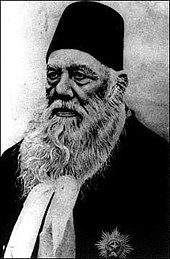
A | B | C | D | E | F | G | H | CH | I | J | K | L | M | N | O | P | Q | R | S | T | U | V | W | X | Y | Z | 0 | 1 | 2 | 3 | 4 | 5 | 6 | 7 | 8 | 9
Islamic Republic of Pakistan | |
|---|---|
| Motto: Īmān, Ittihād, Nazam ایمان، اتحاد، نظم "Faith, Unity, Discipline"[2] | |
| Anthem: Qaumī Tarānah قَومی ترانہ "The National Anthem" | |
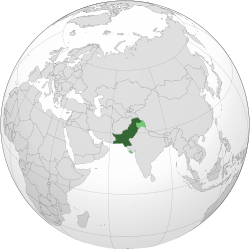 Land controlled by Pakistan shown in dark green; land claimed but not controlled shown in light green | |
| Capital | Islamabad 33°41′30″N 73°03′00″E / 33.69167°N 73.05000°E |
| Largest city | Karachi 24°51′36″N 67°00′36″E / 24.86000°N 67.01000°E |
| Official languages | |
| Native languages | Over 77 languages[4] |
| Religion | |
| Demonym(s) | Pakistani |
| Government | Federal Islamic parliamentary republic |
| Asif Ali Zardari | |
| Shehbaz Sharif | |
| Yusuf Raza Gilani | |
| Ayaz Sadiq | |
| Qazi Faez Isa | |
| Legislature | Parliament |
| Senate | |
| National Assembly | |
| Independence from the United Kingdom | |
| 23 March 1940 | |
| 14 August 1947 | |
• Republic | 23 March 1956 |
| 8 December 1958 | |
| 16 December 1971 | |
| 14 August 1973 | |
| Area | |
• Total | 881,913 km2 (340,509 sq mi)[b][7] (33rd) |
• Water (%) | 2.86 |
| Population | |
• 2023 census | |
• Density | 273.8/km2 (709.1/sq mi) (56th) |
| GDP (PPP) | 2024 estimate |
• Total | |
• Per capita | |
| GDP (nominal) | 2023 estimate |
• Total | |
• Per capita | |
| Gini (2018) | low |
| HDI (2022) | low (164th) |
| Currency | Pakistani rupee (₨) (PKR) |
| Time zone | UTC+05:00 (PKT) |
| DST is not observed. | |
| Date format |
|
| Driving side | left[11] |
| Calling code | +92 |
| ISO 3166 code | PK |
| Internet TLD | |
Pakistan,[e] officially the Islamic Republic of Pakistan,[f] is a country in South Asia. It is the fifth-most populous country, with a population of over 241.5 million, having the second-largest Muslim population as of 2023.[8] Islamabad is the nation's capital, while Karachi is its largest city and financial centre. Pakistan is the 33rd-largest country by area and the ninth-largest in Asia. Bounded by the Arabian Sea on the south, the Gulf of Oman on the southwest, and the Sir Creek on the southeast, it shares land borders with India to the east; Afghanistan to the west; Iran to the southwest; and China to the northeast. It shares a maritime border with Oman in the Gulf of Oman, and is separated from Tajikistan in the northwest by Afghanistan's narrow Wakhan Corridor.
Pakistan is the site of several ancient cultures, including the 8,500-year-old Neolithic site of Mehrgarh in Balochistan, the Indus Valley civilisation of the Bronze Age,[12] and the ancient Gandhara civilisation.[13] The regions that comprise the modern state of Pakistan were the realm of multiple empires and dynasties, including the Achaemenid, the Maurya, the Kushan, the Gupta;[14] the Umayyad Caliphate in its southern regions, the Samma, the Hindu Shahis, the Shah Miris, the Ghaznavids, the Delhi Sultanate, the Mughals,[15] and most recently, the British Raj from 1858 to 1947.
Spurred by the Pakistan Movement, which sought a homeland for the Muslims of British India, and election victories in 1946 by the All-India Muslim League, Pakistan gained independence in 1947 after the Partition of the British Indian Empire, which awarded separate statehood to its Muslim-majority regions and was accompanied by an unparalleled mass migration and loss of life.[16][17] Initially a Dominion of the British Commonwealth, Pakistan officially drafted its constitution in 1956, and emerged as a declared Islamic republic. In 1971, the exclave of East Pakistan seceded as the new country of Bangladesh after a nine-month-long civil war. In the following four decades, Pakistan has been ruled by governments whose descriptions, although complex, commonly alternated between civilian and military, democratic and authoritarian, relatively secular and Islamist.[18]
Pakistan is considered a middle power nation,[19][g] with the world's sixth-largest standing armed forces. It is a declared nuclear-weapons state, and is ranked amongst the emerging and growth-leading economies,[20] with a large and rapidly-growing middle class.[21][22] Pakistan's political history since independence has been characterized by periods of significant economic and military growth as well as those of political and economic instability. It is an ethnically and linguistically diverse country, with similarly diverse geography and wildlife. The country continues to face challenges, including poverty, illiteracy, corruption, and terrorism.[23][24][25] Pakistan is a member of the United Nations, the Shanghai Cooperation Organisation, the Organisation of Islamic Cooperation, the Commonwealth of Nations, the South Asian Association for Regional Cooperation, and the Islamic Military Counter-Terrorism Coalition, and is designated as a major non-NATO ally by the United States.
Etymology
The name Pakistan was coined by Choudhry Rahmat Ali, a Pakistan Movement activist, who in January 1933 first published it (originally as "Pakstan") in a pamphlet Now or Never, using it as an acronym.[26][27][28] Rahmat Ali explained: "It is composed of letters taken from the names of all our homelands, Indian and Asian, Panjab, Afghania, Kashmir, Sindh, and Baluchistan." He added, "Pakistan is both a Persian and Urdu word... It means the land of the Paks, the spiritually pure and clean."[29] Etymologists note that پاک pāk, is 'pure' in Persian and Pashto and the Persian suffix ـستان -stan means 'land' or 'place of'.[27]
Rahmat Ali's concept of Pakistan only related to the north-west area of the Indian subcontinent. He also proposed the name "Banglastan" for the Muslim areas of Bengal and "Osmanistan" for Hyderabad State, as well as a political federation between the three.[30]
History
Indus Valley Civilisation
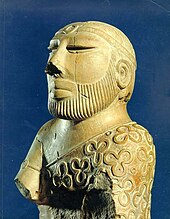
Some of the earliest ancient human civilisations in South Asia originated from areas encompassing present-day Pakistan.[32] The earliest known inhabitants in the region were Soanian during the Lower Paleolithic, of whom artefacts have been found in the Soan Valley of Punjab.[33] The Indus region, which covers most of the present-day Pakistan, was the site of several successive ancient cultures including the Neolithic (7000–4300 BCE) site of Mehrgarh,[34][35][36] and the 5,000-year history of urban life in South Asia to the various sites of the Indus Valley Civilisation, including Mohenjo-daro and Harappa.[37][38]
Vedic period

Following the decline of the Indus valley civilization, Indo-Aryan tribes moved into the Punjab from Central Asia in several waves of migration in the Vedic period (1500–500 BCE),[40] bringing with them their distinctive religious traditions and practices which fused with local culture.[41] The Indo-Aryans religious beliefs and practices from the Bactria–Margiana culture and the native Harappan Indus beliefs of the former Indus Valley Civilization eventually gave rise to Vedic culture and tribes.[41] Most notable among them was Gandhara civilization, which flourished at the crossroads of India, Central Asia, and the Middle East, connecting trade routes and absorbing cultural influences from diverse civilizations.[42] The initial early Vedic culture was a tribal, pastoral society centered in the Indus Valley, of what is today Pakistan.[43] During this period the Vedas, the oldest scriptures of Hinduism, were composed.[44][h]
Classical period

The western regions of Pakistan became part of Achaemenid Empire around 517 BCE.[46] In 326 BCE, Alexander the Great conquered the region by defeating various local rulers, most notably, the King Porus, at Jhelum.[47] It was followed by the Maurya Empire, founded by Chandragupta Maurya and extended by Ashoka the Great, until 185 BCE.[48][49][50] The Indo-Greek Kingdom founded by Demetrius of Bactria (180–165 BCE) included Gandhara and Punjab and reached its greatest extent under Menander (165–150 BCE), prospering the Greco-Buddhist culture in the region.[51][52][53] Taxila had one of the earliest universities and centres of higher education in the world, which was established during the late Vedic period in the 6th century BCE.[54] The ancient university was documented by the invading forces of Alexander the Great and was also recorded by Chinese pilgrims in the 4th or 5th century CE.[55][56][57]
At its zenith, the Rai dynasty (489–632 CE) ruled Sindh and the surrounding territories.[58]
Islamic conquest
The Arab conqueror Muhammad ibn Qasim conquered Sindh and some regions of Punjab in 711 CE.[48][59] The Pakistan government's official chronology claims this as the time when the foundation of Pakistan was laid.[60] The Early Medieval period (642–1219 CE) witnessed the spread of Islam in the region.[61] Before the arrival of Islam beginning in the 8th century, the region comprising Pakistan was home to a diverse plethora of faiths, including Hinduism, Buddhism, Jainism and Zoroastrianism.[62][63] During this period, Sufi missionaries played a pivotal role in converting a majority of the regional population to Islam.[64] Upon the defeat of the Turk and Hindu Shahi dynasties which governed the Kabul Valley, Gandhara (present-day Khyber Pakhtunkwa), and western Punjab in the 7th to 11th centuries CE, several successive Muslim empires ruled over the region, including the Ghaznavid Empire (975–1187 CE), the Ghorid Kingdom, and the Delhi Sultanate (1206–1526 CE).[65] The Lodi dynasty, the last of the Delhi Sultanate, was replaced by the Mughal Empire (1526–1857 CE).[66]

The Mughals introduced Persian literature and high culture, establishing the roots of Indo-Persian culture in the region.[67] In the region of modern-day Pakistan, key cities during the Mughal period were Multan, Lahore, Peshawar and Thatta,[68] which were chosen as the site of impressive Mughal buildings.[69] In the early 16th century, the region remained under the Mughal Empire.[70] In the 18th century, the slow disintegration of the Mughal Empire was hastened by the emergence of the rival powers of the Maratha Confederacy and later the Sikh Empire, as well as invasions by Nader Shah from Iran in 1739 and the Durrani Empire of Afghanistan in 1759.[11][71] The growing political power of the British in Bengal had not yet reached the territories of modern Pakistan.[72]
Colonial period
None of modern Pakistan was under British rule until 1839 when Karachi, a small fishing village governed by Talpurs of Sindh with a mud fort guarding the harbour, was taken,[77][78] and used as an enclave with a port and military base for the First Afghan War that ensued.[79] The remainder of Sindh was acquired in 1843,[80] and subsequently, through a series of wars and treaties, the East India Company, and later, after the post-Sepoy Mutiny (1857–1858), direct rule by Queen Victoria of the British Empire, acquired most of the region.[81] Key conflicts included those against the Baloch Talpur dynasty, resolved by the Battle of Miani (1843) in Sindh,[82] the Anglo-Sikh Wars (1845–1849),[83] and the Anglo-Afghan Wars (1839–1919).[84] By 1893, all modern Pakistan was part of the British Indian Empire, and remained so until independence in 1947.[85]
Under British rule, modern Pakistan was primarily divided into the Sind Division, Punjab Province, and the Baluchistan Agency. The region also included various princely states, with the largest being Bahawalpur.[86][87]
The major armed struggle against the British in the region was the rebellion known as the Sepoy Mutiny in 1857.[88] Divergence in the relationship between Hinduism and Islam resulted in significant tension in British India, leading to religious violence. The language controversy further exacerbated tensions between Hindus and Muslims.[75][89] A Muslim intellectual movement, led by Sir Syed Ahmed Khan to counter the Hindu renaissance, advocated for the two-nation theory and led to the establishment of the All-India Muslim League in 1906.[73][74][75]
In March 1929, in response to the Nehru Report, Muhammad Ali Jinnah, the founder of Pakistan, issued his fourteen points, which included proposals to safeguard the interests of the Muslim minority in a united India. These proposals were rejected, thus paving the way for the partition of India.[90][91] In his December 29, 1930 address, Allama Iqbal advocated for the two-nation theory by proposing the amalgamation of Muslim-majority states in North-West India, including Punjab, North-West Frontier Province, Sind, and Baluchistan.[92][93] The perception that Congress-led British provincial governments neglected the Muslim League from 1937 to 1939 motivated Jinnah and other Muslim League leaders to embrace the two-nation theory.[94][95] This led to the adoption of the Lahore Resolution of 1940, presented by Sher-e-Bangla A.K. Fazlul Haque, also known as the Pakistan Resolution.[96]
By 1942, Britain faced considerable strain during World War II, with India directly threatened by Japanese forces. Britain had pledged voluntary independence for India in exchange for support during the war. However, this pledge included a clause stating that no part of British India would be compelled to join the resulting dominion. Gandhi and Congress leadership interpreted this as support for an independent Muslim nation. In response, Congress, led by Gandhi, launched the Quit India Movement, demanding an immediate end to British rule. In contrast, the Muslim League chose to support the UK's war efforts and abstained from joining the Quit India Movement, thereby nurturing the possibility of establishing a Muslim nation.[97][98]
Pakistan Movement

The 1946 elections saw the Muslim League secure 90 percent of the Muslim seats, supported by the landowners of Sindh and Punjab. This forced the Indian National Congress, initially skeptical of the League's representation of Indian Muslims, to acknowledge its significance.[99] Jinnah's emergence as the voice of the Indian Muslims,[60] compelled the British to consider their stance, despite their reluctance to partition India. In a final attempt to prevent partition, they proposed the Cabinet Mission Plan.[100]
As the Cabinet Mission failed, the British announced their intention to end rule by June 1948.[101][102] Following rigorous discussions involving Viceroy of India, Lord Mountbatten of Burma, Muhammad Ali Jinnah of the All-India Muslim League, and Jawaharlal Nehru of Congress, the formal declaration to partition British India into two independent dominions—namely Pakistan and India—was issued by Mountbatten on the evening of 3 June 1947. In Mountbatten's oval office, the prime ministers of around a dozen major princely states gathered to receive their copies of the plan before its worldwide broadcast. At 7:00 P.M., All India Radio transmitted the public announcement, starting with the viceroy's address, followed by individual speeches from Nehru, and Jinnah, with founder of Pakistan Muhammad Ali Jinnah concluding his address with the slogan Pakistan Zindabad (Long Live Pakistan).[103]
As the United Kingdom agreed to the partitioning of India,[103] the modern state of Pakistan was established on 14 August 1947 (27th of Ramadan in 1366 of the Islamic Calendar, considered to be the most blessed date from an Islamic perspective).[104][105] This new nation amalgamated the Muslim-majority eastern and northwestern regions of British India, comprising the provinces of Balochistan, East Bengal, the North-West Frontier Province, West Punjab, and Sindh.[106]
In the riots that accompanied the partition in Punjab Province, between 200,000 and 2,000,000[107][108] people were killed in what some have described as a retributive genocide between the religions.[109] Around 50,000 Muslim women were abducted and raped by Hindu and Sikh men, while 33,000 Hindu and Sikh women experienced the same fate at the hands of Muslims.[110] Around 6.5 million Muslims moved from India to West Pakistan and 4.7 million Hindus and Sikhs moved from West Pakistan to India.[111] It was the largest mass migration in human history.[112] A subsequent dispute over the princely state of Jammu and Kashmir eventually sparked the Indo-Pakistani War of 1947–1948.[113]
Post Independence

After independence in 1947, Jinnah, the President of the Muslim League, became Pakistan's first Governor-General and the first President-Speaker of the Parliament, but he succumbed to tuberculosis on 11 September 1948.[114] Meanwhile, Pakistan's founding fathers agreed to appoint Liaquat Ali Khan, the secretary-general of the party, the nation's first Prime Minister. From 1947 to 1956, Pakistan was a monarchy within the Commonwealth of Nations, and had two monarchs before it became a republic.[115]
The creation of Pakistan was never fully accepted by many British leaders including Lord Mountbatten.[116] Mountbatten expressed his lack of support and faith in the Muslim League's idea of Pakistan.[117] Jinnah refused Mountbatten's offer to serve as Governor-General of Pakistan.[118] When Mountbatten was asked by Collins and Lapierre if he would have sabotaged Pakistan had he known that Jinnah was dying of tuberculosis, he replied 'most probably'.[119]
"You are free; you are free to go to your temples, you are free to go to your mosques or to any other place of worship in this State of Pakistan. You may belong to any religion or caste or creed – that has nothing to do with the business of the State."
—Muhammad Ali Jinnah's first speech to the Constituent Assembly of Pakistan[120]
Maulana Shabbir Ahmad Usmani, a respected Deobandi alim (scholar) who held the position of Shaykh al-Islam in Pakistan in 1949, and Maulana Mawdudi of Jamaat-i-Islami played key roles in advocating for an Islamic constitution. Mawdudi insisted that the Constituent Assembly declare the "supreme sovereignty of God" and the supremacy of the shariah in Pakistan.[121]
The efforts of Jamaat-i-Islami and the ulama led to the passage of the Objectives Resolution in March 1949. This resolution, described by Liaquat Ali Khan as the second most significant step in Pakistan's history, affirmed that "sovereignty over the entire universe belongs to God Almighty alone and the authority which He has delegated to the State of Pakistan through its people for being exercised within the limits prescribed by Him is a sacred trust". It was later included as a preamble to the constitutions of 1956, 1962, and 1973.[122]
Democracy faced setbacks due to the martial law imposed by President Iskander Mirza, who was succeeded by General Ayub Khan. After adopting a presidential system in 1962, Pakistan witnessed significant growth until the second war with India in 1965, resulting in an economic downturn and widespread public discontent in 1967.[123][124] In 1969, President Yahya Khan consolidated control, but faced a devastating cyclone in East Pakistan resulting in 500,000 deaths.[125]
In 1970, Pakistan conducted its first democratic elections since independence, intending to transition from military rule to democracy. However, after the East Pakistani Awami League emerged victorious over the Pakistan Peoples Party (PPP), Yahya Khan and the military refused to transfer power.[126][127] This led to Operation Searchlight, a military crackdown, and eventually sparked the war of liberation by Bengali Mukti Bahini forces in East Pakistan,[127][128] described in West Pakistan as a civil war rather than a liberation struggle.[129]

Independent researchers estimate that between 300,000 and 500,000 civilians died during this period while the Bangladesh government puts the number of dead at three million,[130] a figure that is now nearly universally regarded as excessively inflated.[131] Some academics such as Rudolph Rummel and Rounaq Jahan say both sides[132] committed genocide; others such as Richard Sisson and Leo E. Rose believe there was no genocide.[133] In response to India's support for the insurgency in East Pakistan, preemptive strikes on India by Pakistan's air force, navy, and marines sparked a conventional war in 1971 that resulted in an Indian victory and East Pakistan gaining independence as Bangladesh.[127]
With Pakistan surrendering in the war, Yahya Khan was replaced by Zulfikar Ali Bhutto as president; the country worked towards promulgating its constitution and putting the country on the road to democracy. Democratic rule resumed from 1972 to 1977—an era of self-consciousness, intellectual leftism, nationalism, and nationwide reconstruction.[134] In 1972 Pakistan embarked on an ambitious plan to develop its nuclear deterrence capability with the goal of preventing any foreign invasion; the country's first nuclear power plant was inaugurated in that same year.[135][136] Accelerated in response to India's first nuclear test in 1974, this crash program was completed in 1979.[136]
Democracy ended with a military coup in 1977 against the leftist PPP, which saw General Zia-ul-Haq become the president in 1978. From 1977 to 1988, President Zia's corporatisation and economic Islamisation initiatives led to Pakistan becoming one of the fastest-growing economies in South Asia.[137] While building up the country's nuclear program, increasing Islamisation,[138] and the rise of a homegrown conservative philosophy, Pakistan helped subsidise and distribute US resources to factions of the mujahideen against the USSR's intervention in communist Afghanistan.[139] Pakistan's North-West Frontier Province became a base for the anti-Soviet Afghan fighters, with the province's influential Deobandi ulama playing a significant role in encouraging and organising the 'jihad'.[140]
President Zia died in a plane crash in 1988, and Benazir Bhutto, daughter of Zulfikar Ali Bhutto, was elected as the country's first female Prime Minister. The PPP was followed by conservative Pakistan Muslim League (N) (PML (N)), and over the next decade the leaders of the two parties fought for power, alternating in office. This period is marked by prolonged stagflation, instability, corruption, nationalism, geopolitical rivalry with India, and the clash of left wing-right wing ideologies.[141] As PML (N) secured a supermajority in elections in 1997, Nawaz Sharif authorised nuclear testings, as a retaliation to the second nuclear tests conducted by India in May 1998.[142]

Military tension between the two countries in the Kargil district led to the Kargil War of 1999, and turmoil in civic-military relations allowed General Pervez Musharraf to take over through a bloodless coup d'état.[143][144] Musharraf governed Pakistan as chief executive from 1999 to 2001 and as President from 2001 to 2008—a period of enlightenment, social liberalism, extensive economic reforms,[145] and direct involvement in the US-led war on terrorism. By its own financial calculations, Pakistan's involvement in the war on terrorism has cost up to $118 billion,[146] sixty thousand casualties and more than 1.8 million displaced civilians.[147]
The National Assembly historically completed its first full five-year term on 15 November 2007.[148] After the assassination of Benazir Bhutto in 2007, the PPP secured the most votes in the elections of 2008, appointing party member Yusuf Raza Gilani as Prime Minister.[149] Threatened with impeachment, President Musharraf resigned on 18 August 2008, and was succeeded by Asif Ali Zardari.[150] Clashes with the judicature prompted Gilani's disqualification from the Parliament and as the Prime Minister in June 2012.[151] The general election held in 2013 saw the PML (N) almost achieve a supermajority, following which Nawaz Sharif was elected as the Prime Minister for the third time.[152] In 2018, PTI won the general election and Imran Khan became the 22nd Prime Minister.[153] In April 2022, Shehbaz Sharif was elected as prime minister, after Imran Khan lost a no-confidence vote.[154] During 2024 general election, PTI-backed independents became the largest bloc,[155] but Shehbaz Sharif was elected prime minister for a second term, as a result of a coalition between PML (N) and PPPP.[156]
Geography
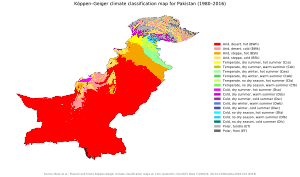
Pakistan's diverse geography and climate host a wide array of wildlife.[157] Covering 881,913 km2 (340,509 sq mi), Pakistan's size is comparable to France and the UK combined. It ranks as the 33rd-largest nation by total area, but this varies based on Kashmir's disputed status. Pakistan boasts a 1,046 km (650 mi) coastline along the Arabian Sea and the Gulf of Oman,[158] and shares land borders totaling 6,774 km (4,209 mi), including 2,430 km (1,510 mi) with Afghanistan, 523 km (325 mi) with China, 2,912 km (1,809 mi) with India, and 909 km (565 mi) with Iran.[159] It has a maritime border with Oman,[160] and shares a border with Tajikistan via the Wakhan Corridor.[161] Situated at the crossroads of South Asia, the Middle East, and Central Asia,[162] Pakistan's location is geopolitically significant. Geologically, Pakistan straddles the Indus–Tsangpo Suture Zone and the Indian tectonic plate in Sindh and Punjab, while Balochistan and most of Khyber Pakhtunkhwa sit on the Eurasian plate, primarily on the Iranian plateau. Gilgit-Baltistan and Azad Kashmir, along the Indian plate's edge, are susceptible to powerful earthquakes.[163]

Pakistan's landscapes vary from coastal plains to glaciated mountains, offering deserts, forests, hills, and plateaus.[164] Pakistan is divided into three major geographic areas: the northern highlands, the Indus River plain, and the Balochistan Plateau.[165] The northern highlands feature the Karakoram, Hindu Kush, and Pamir mountain ranges, hosting some of the world's highest peaks, including five of the fourteen eight-thousanders (mountain peaks over 8,000 metres or 26,250 feet), notably K2 (8,611 m or 28,251 ft) and Nanga Parbat (8,126 m or 26,660 ft).[166] The Balochistan Plateau lies in the west and the Thar Desert in the east. The 1,609 km (1,000 mi) Indus River and its tributaries traverse the nation from Kashmir to the Arabian Sea, sustaining alluvial plains along the Punjab and Sindh regions.[167]
The climate varies from tropical to temperate, with arid conditions in the coastal south. There is a monsoon season with frequent flooding due to heavy rainfall, and a dry season with significantly less rainfall or none at all. Pakistan experiences four distinct seasons: a cool, dry winter from December through February; a hot, dry spring from March through May; the summer rainy season, or southwest monsoon period, from June through September; and the retreating monsoon period of October and November.[168] Rainfall varies greatly from year to year, with patterns of alternate flooding and drought common.[169]
Flora and fauna
The diverse landscape and climate in Pakistan support a wide range of trees and plants. From coniferous alpine and subalpine trees like spruce, pine, and deodar cedar in the northern mountains to deciduous trees like shisham in the Sulaiman Mountains, and palms such as coconut and date in the southern regions. The western hills boast juniper, tamarisk, coarse grasses, and scrub plants. Mangrove forests dominate the coastal wetlands in the south.[170] Coniferous forests span altitudes from 1,000 to 4,000 metres (3,300 to 13,100 feet) in most northern and northwestern highlands. In Balochistan's xeric regions, date palms and Ephedra are prevalent. In Punjab and Sindh's Indus plains, tropical and subtropical dry and moist broadleaf forests as well as tropical and xeric shrublands thrive.[171] Approximately 2.2% or 1,687,000 hectares (16,870 km2) of Pakistan was forested in 2010.[172]

Pakistan's fauna mirrors its diverse climate. The country boasts around 668 bird species,[174] including crows, sparrows, mynas, hawks, falcons, and eagles. Palas, Kohistan, is home to the western tragopan,[175] with many migratory birds visiting from Europe, Central Asia, and India.[176] The southern plains harbor mongooses, small Indian civet, hares, the Asiatic jackal, the Indian pangolin, the jungle cat, and the desert cat. Indus is home to mugger crocodiles, while surrounding areas host wild boars, deer, porcupines, and small rodents. Central Pakistan's sandy scrublands shelter Asiatic jackals, striped hyenas, wildcats, and leopards.[177][178] The mountainous north hosts a variety of animals like the Marco Polo sheep, urial, markhor goat, ibex goat, Asian black bear, and Himalayan brown bear.[177][179][180]
The lack of vegetative cover, severe climate, and grazing impact on deserts have endangered wild animals. The chinkara is the only animal found in significant numbers in Cholistan, with a few nilgai along the Pakistan–India border and in some parts of Cholistan.[177][181] Rare animals include the snow leopard and the blind Indus river dolphin, of which there are believed to be about 1,100 remaining, protected at the Indus Dolphin Reserve in Sindh.[179][182] In total, 174 mammals, 177 reptiles, 22 amphibians, 198 freshwater fish species and 5,000 species of invertebrates (including insects) have been recorded in Pakistan.[174] Pakistan faces deforestation, hunting, and pollution, with a 2019 Forest Landscape Integrity Index mean score of 7.42/10, ranking 41st globally out of 172 countries.[183]
Government and politics

Pakistan operates as a democratic parliamentary federal republic, with Islam designated as the state religion.[184] Initially adopting a constitution in 1956, Pakistan saw it suspended by Ayub Khan in 1958, replaced by a second constitution in 1962.[185] A comprehensive constitution emerged in 1973, suspended by Zia-ul-Haq in 1977 but reinstated in 1985, shaping the country's governance.[159] The military's influence in mainstream politics has been significant throughout Pakistan's history.[186] The eras of 1958–1971, 1977–1988, and 1999–2008 witnessed military coups, leading to martial law and military leaders governing de facto as presidents.[187] Presently, Pakistan operates a multi-party parliamentary system with distinct checks and balances among government branches. The first successful democratic transition occurred in May 2013. Pakistani politics revolves around a blend of socialism, conservatism, and the third way, with the three main political parties being the conservative PML (N), socialist PPP, and centrist PTI. Constitutional amendments in 2010 curtailed presidential powers, enhancing the role of the prime minister.[188]
- Head of State: The ceremonial head of the state and civilian commander-in-chief of the Pakistan Armed Forces is the President, elected by an Electoral College. The Prime Minister appoints military personnel and key confirmations after reviewing merit and performance reports. Almost all judicature, military, and legislative appointments require executive confirmation, with the President holding powers to pardon and grant clemency.
- Legislative: The bicameral legislature includes a 104-member Senate (upper house) and a 342-member National Assembly (lower house). National Assembly members are elected via first-past-the-post under universal adult suffrage, representing National Assembly constituencies. The constitution reserves 70 seats for women and religious minorities, allocated to political parties based on proportional representation. Senate members are elected by provincial legislators, ensuring equal representation across all provinces.
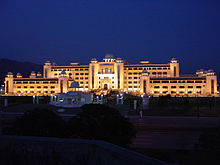
- Executive: The Prime Minister, typically the leader of the majority rule party or coalition in the National Assembly (the lower house), serves as the country's chief executive and head of government. Responsibilities include forming a cabinet, making executive decisions, and appointing senior civil servants, subject to executive confirmation.
- Provincial governments: Each of the four provinces follows a similar governance system, with a directly elected Provincial Assembly choosing the Chief Minister, usually from the largest party or coalition. Chief Ministers lead the provincial cabinet and oversee provincial governance. The Chief Secretary, appointed by the Prime Minister, heads the provincial bureaucracy. Provincial assemblies legislate and approve the provincial budget, typically presented by the provincial finance minister annually. Ceremonial heads of provinces, the Provincial Governors, are appointed by the President.[159]
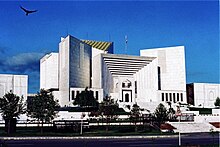
- Judicature: The judiciary in Pakistan has two classes: the superior and subordinate judiciary. The Chief Justice of Pakistan oversees the court system at all levels. The superior judiciary includes the Supreme Court of Pakistan, Federal Shariat Court, and five high courts, with the Supreme Court at the top. It's responsible for safeguarding the constitution. Azad Kashmir and Gilgit-Baltistan have their own court systems.
Role of Islam
Pakistan, the only country established in the name of Islam,[189] had overwhelming support among Muslims, especially in provinces like the United Provinces, where Muslims were a minority.[190] This idea, articulated by the Muslim League, the Islamic clergy, and Jinnah, envisioned an Islamic state.[191] Jinnah, closely associated with the ulama, was described upon his death by Maulana Shabbir Ahmad Usmani as the greatest Muslim after Aurangzeb, aspiring to unite Muslims worldwide under Islam.[192]
The Objectives Resolution of March 1949 marked the initial step towards this goal, affirming God as the sole sovereign.[193][122] Muslim League leader Chaudhry Khaliquzzaman asserted that Pakistan could only truly become an Islamic state after bringing all believers of Islam into a single political unit.[194] Keith Callard observed that Pakistanis believed in the essential unity of purpose and outlook in the Muslim world, expecting similar views on religion and nationality from Muslims worldwide.[195]

Pakistan's desire for a united Islamic bloc, called Islamistan, wasn't supported by other Muslim governments,[196] though figures like the Grand Mufti of Palestine, Al-Haj Amin al-Husseini, and leaders of the Muslim Brotherhood were drawn to the country. Pakistan's desire for an international organization of Muslim countries was fulfilled in the 1970s when the Organization of Islamic Conference (OIC) was formed.[197] East Pakistan's Bengali Muslims, opposed to an Islamist state, clashed with West Pakistanis who leaned towards Islamic identity.[198][199] The Islamist party Jamaat-e-Islami backed an Islamic state and opposed Bengali nationalism.[200]
After the 1970 general elections, the Parliament crafted the 1973 Constitution.[201] It declared Pakistan an Islamic Republic, with Islam as the state religion, and mandated laws to comply with Islamic teachings laid down in the Quran and Sunnah and that no law repugnant to such injunctions could be enacted.[202] Additionally, it established institutions like the Shariat Court and the Council of Islamic Ideology to interpret and apply Islam.[203]
Zulfikar Ali Bhutto faced opposition under the banner of Nizam-e-Mustafa ("Rule of the Prophet"),[204] advocating an Islamic state. Bhutto conceded to some Islamist demands before being ousted in a coup.[205]
General Zia-ul-Haq, after seizing power, committed to establishing an Islamic state and enforcing sharia law.[205] He instituted Shariat judicial courts[206] and court benches[207] to adjudicate using Islamic doctrine.[208]{{Wynbrandt quote: "Zia, however, tried to bolster the influence of Islamic parties and the ulama on government and society." ([208])}} Zia aligned with Deobandi institutions,[209] exacerbating sectarian tensions with anti-Shia policies.[210]
Most Pakistanis, according to a Pew Research Center (PEW) poll, favor Sharia law as the official law,[211] and identify more with religion than nationality compared to Muslims in other nations such as Egypt, Indonesia, and Jordan.[212]
Administrative divisions
| Administrative division | Capital | Population |
|---|---|---|
| Quetta | 12,344,408 | |
| Lahore | 110,126,285 | |
| Karachi | 47,886,051 | |
| Peshawar | 40,525,047 | |
| Gilgit | 1,800,000 | |
| Muzaffarabad | 4,567,982 | |
| Islamabad Capital Territory | Islamabad | 2,851,868 |
Pakistan, a federal parliamentary republic, consists of four provinces: Punjab, Khyber Pakhtunkhwa, Sindh, and Balochistan,[213] along with three territories: Islamabad Capital Territory, Gilgit-Baltistan, and Azad Kashmir. The Government of Pakistan governs the western parts of the Kashmir Region, organized into separate political entities, Azad Kashmir and Gilgit-Baltistan. In 2009, the constitutional assignment (the Gilgit–Baltistan Empowerment and Self-Governance Order) granted Gilgit-Baltistan semi-provincial status, providing it with self-government.[214]
The local government system comprises districts, tehsils, and union councils, with an elected body at each tier.[215] There are approximately 170 districts in total, with ten in Azad Kashmir[216] and fourteen in Gilgit-Baltistan.[217]
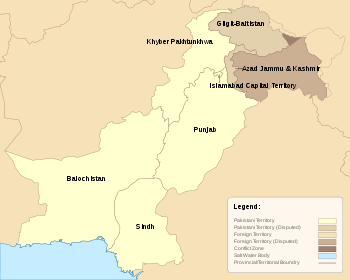
Foreign relations
Since Independence, Pakistan has aimed to balance its foreign relations.[218] Pakistan's foreign policy and geostrategy focus on the economy, security, national identity, and territorial integrity, as well as building close ties with other Muslim nations.[219] According to Hasan Askari Rizvi, a foreign policy expert, "Pakistan highlights sovereign equality of states, bilateralism, mutuality of interests, and non-interference in each other's domestic affairs as the cardinal features of its foreign policy."[220]
The Kashmir conflict remains a major issue between Pakistan and India, with three of their four wars fought over it.[221] Due partly to strained relations with India, Pakistan has close ties with Turkey and Iran,[222] both focal points in its foreign policy.[222] Saudi Arabia also holds importance in Pakistan's foreign relations.
As a non-signatory of the Treaty on Nuclear Non-Proliferation, Pakistan holds influence in the IAEA.[223] In 2010, Pakistan blocked an international treaty to limit fissile material, arguing it targeted Pakistan specifically.[224] Pakistan's nuclear program in the 20th century aimed to counter India's nuclear ambitions in the region, and reciprocal nuclear tests ensued after India's nuclear tests, solidifying Pakistan as a nuclear power.[225] Pakistan maintains a policy of Full spectrum deterrence, considering its nuclear program vital for deterring foreign aggression.[226][227]
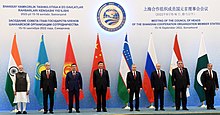
Located strategically in the world's major maritime oil supply lines and communication fiber optic corridors, Pakistan also enjoys proximity to the natural resources of Central Asian countries.[228] Pakistan actively participates in the United Nations with a Permanent Representative representing its positions in international politics.[229] It has advocated for the concept of "enlightened moderation" in the Muslim world.[230] Pakistan is a member of the Commonwealth of Nations,[231] SAARC, ECO,[232] and the G20 developing nations.[233]

Pakistan is designated as an "Iron Brother" by China,[234][235] emphasizing the significance of their close and supportive relationship.[236] In the 1950s, Pakistan opposed the Soviet Union for geopolitical reasons. During the Soviet–Afghan War in the 1980s, it was a close ally of the United States.[220][237] Relations with Russia have improved since 1999,[238] but Pakistan's relationship with the United States has been "on-and-off." Initially, Pakistan was a close ally during the Cold War, but relations soured in the 1990s due to US sanctions over its secretive nuclear program.[239] Since 9/11, Pakistan has been a US ally on counterterrorism, but their relationship has been strained due to diverging interests and mistrust during the 20-year war and terrorism issues.[240] Although Pakistan was granted major non-NATO ally status by the US in 2004,[241] its intelligence agency, including ISI, faced accusations of supporting the Taliban insurgents until US troops withdrew from Afghanistan.[242][243][244]
Pakistan does not have formal diplomatic relations with Israel;[245] however, some Israeli citizens have visited Pakistan on tourist visas.[246] Nonetheless, an exchange occurred between the two countries using Turkey as an intermediary.[247] Despite not establishing formal diplomatic relations with Armenia, Pakistan is home to an Armenian community.[248]
Relations with China

Pakistan was among the first nations to establish formal diplomatic ties with the China, forging a strong relationship since China's 1962 conflict with India, culminating in a special bond.[250] Throughout the 1960s to 1980s, Pakistan played a crucial role in China's global outreach, facilitating US President Richard Nixon's historic visit to China.[250] Despite changes in Pakistani governance and regional/global dynamics, China's influence in Pakistan remains paramount.[250] In reciprocation, China stands as Pakistan's largest trading partner, with substantial investment in Pakistani infrastructure, notably the Gwadar port. In 2015 alone, they inked 51 agreements and Memorandums of Understanding (MoUs) for cooperative efforts.[251] Both nations signed a Free Trade Agreement in the 2000s, with China making its largest investment in Pakistan's history through CPEC.[252] Pakistan acts as China's liaison to the Muslim world, and both nations support each other on sensitive issues like Kashmir, Taiwan, Xinjiang, and more.[253]
Emphasis on relations with the Muslim world
After Independence, Pakistan vigorously pursued bilateral relations with other Muslim countries.[254] The Ali brothers sought to project Pakistan as the natural leader of the Islamic world, partly due to its significant manpower and military strength.[255] Khaliquzzaman, a prominent Muslim League leader, declared Pakistan's ambition to unite all Muslim countries into Islamistan, a pan-Islamic entity.[256]
These developments, alongside Pakistan's creation, didn't receive approval from the United States, with British Prime Minister Clement Attlee expressing a hope for India and Pakistan to reunite.[257] However, due to a nationalist awakening in the Arab world at that time, there was little interest in Pakistan's Pan-Islamic aspirations.[258] Some Arab countries perceived the 'Islamistan' project as Pakistan's bid to dominate other Muslim states.[259]
Pakistan vigorously advocated for self-determination among Muslims globally. Its efforts in supporting independence movements in countries like Indonesia, Algeria, Tunisia, Morocco, and Eritrea fostered strong ties.[260] Although initially tense due to the secession war, relations between Pakistan and Bangladesh have deepened recently.[261]
Conversely, Pakistan's relations with Iran have faced strains over sectarian tensions.[262] Iran and Saudi Arabia have used Pakistan as a battleground for their proxy sectarian war. By the 1990s, Pakistan's support for the Sunni Taliban in Afghanistan posed a challenge for Shia-led Iran, which opposed a Taliban-controlled Afghanistan.[263] Tensions escalated in 1998 when Iran accused Pakistan of war crimes after Pakistani warplanes bombed Afghanistan's last Shia stronghold in support of the Taliban.[264] As the Taliban regains power in the 2020s, Pakistan advocates for cooperation among neighboring countries, arguing against the use of Afghanistan for geopolitical rivalry.[265]
Pakistan, a prominent member of the Organisation of Islamic Cooperation (OIC), prioritizes maintaining cultural, political, social, and economic relations with Arab and other Muslim-majority nations in its foreign policy.[266]
Leadership in World governance initiatives
Pakistan signed the agreement to convene a convention for drafting a world constitution, leading to the establishment of the Constitution for the Federation of Earth in 1968.[267][268][269] Muhammad Ayub Khan, then president of Pakistan, endorsed the agreement to convene a World Constituent Assembly.[270][271] Member of Parliament and adviser to the Prime Minister, Ahmed Ebrahim Haroon Jaffer, represented Pakistan at the World Constituent Assembly in Interlaken, Switzerland in August 1968.[272]
In 1982, the inaugural Provisional World Parliament (PWP) convened in Brighton, United Kingdom, with Pakistani jurist and diplomat Sir Chaudhry Mohammad Zafarullah Khan presiding over the session at the Royal Pavilion.[273][274]
Kashmir conflict

Kashmir, a Himalayan region at the northern tip of the Indian subcontinent, was governed as the autonomous princely state of Jammu and Kashmir during the British Raj before the Partition of India in August 1947. This sparked a major territorial dispute between India and Pakistan, resulting in several conflicts over the region. India controls about 45.1% of Kashmir, including Jammu and Kashmir and Ladakh, while Pakistan controls roughly 38.2%, comprising Azad Jammu and Kashmir and Gilgit−Baltistan. Additionally, about 20% of the region, known as Aksai Chin and the Shaksgam Valley, is under Chinese control.[275] India claims the entire Kashmir region based on the Instrument of Accession signed by the princely state's ruler, Maharaja Hari Singh, while Pakistan argues for its Muslim-majority population and geographical proximity to Pakistan. The United Nations was involved in resolving the conflict, leading to a ceasefire in 1949 and the establishment of the Line of Control (LoC) as a de facto border.[276] India, fearing Kashmir's secession, did not hold the promised plebiscite, as it believed Kashmiris would vote to join Pakistan.[277]

Pakistan claims that its position is for the right of the Kashmiri people to determine their future through impartial elections as mandated by the United Nations,[278] while India has stated that Kashmir is an "integral part" of India, referring to the 1972 Simla Agreement and to the fact that regional elections take place regularly.[279] In recent developments, certain Kashmiri independence groups believe that Kashmir should be independent of both India and Pakistan.[221]
Zdroj:https://en.wikipedia.org?pojem=State_of_PakistanText je dostupný za podmienok Creative Commons Attribution/Share-Alike License 3.0 Unported; prípadne za ďalších podmienok. Podrobnejšie informácie nájdete na stránke Podmienky použitia.
Antropológia
Aplikované vedy
Bibliometria
Dejiny vedy
Encyklopédie
Filozofia vedy
Forenzné vedy
Humanitné vedy
Knižničná veda
Kryogenika
Kryptológia
Kulturológia
Literárna veda
Medzidisciplinárne oblasti
Metódy kvantitatívnej analýzy
Metavedy
Metodika
Text je dostupný za podmienok Creative
Commons Attribution/Share-Alike License 3.0 Unported; prípadne za ďalších
podmienok.
Podrobnejšie informácie nájdete na stránke Podmienky
použitia.
www.astronomia.sk | www.biologia.sk | www.botanika.sk | www.dejiny.sk | www.economy.sk | www.elektrotechnika.sk | www.estetika.sk | www.farmakologia.sk | www.filozofia.sk | Fyzika | www.futurologia.sk | www.genetika.sk | www.chemia.sk | www.lingvistika.sk | www.politologia.sk | www.psychologia.sk | www.sexuologia.sk | www.sociologia.sk | www.veda.sk I www.zoologia.sk



